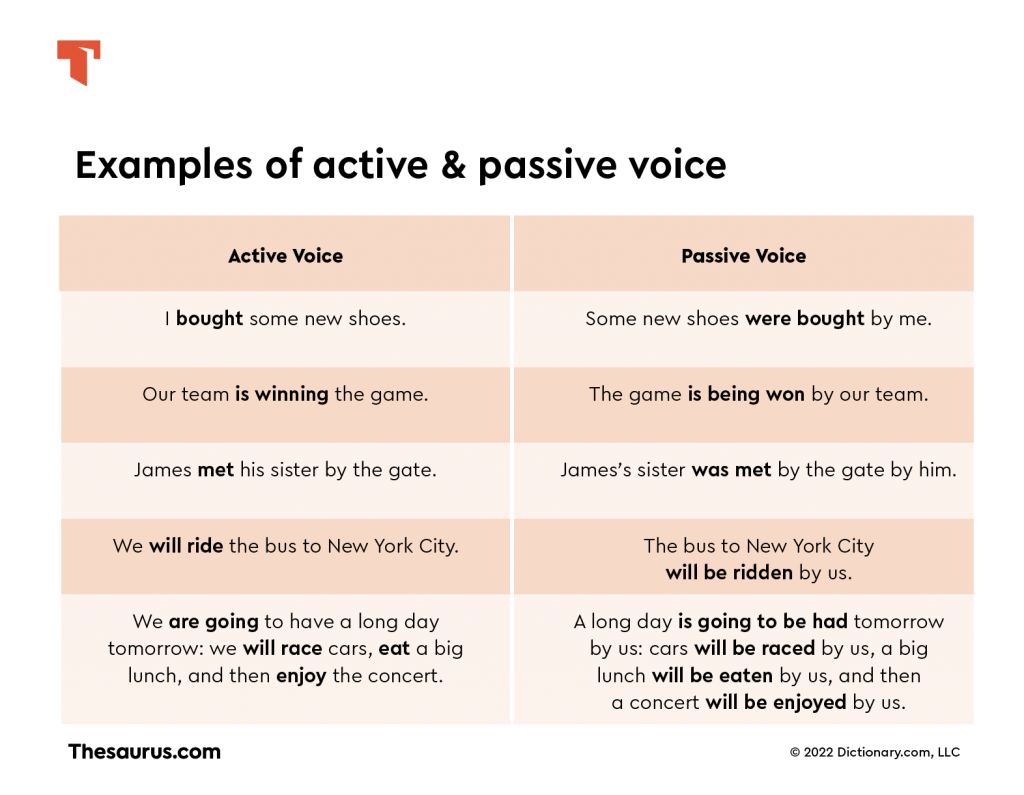The party was held by a generous celebrity. Delicious food was eaten. Songs were sung. Joy and fun was had by all!
Wow! Sounds like a fun party. But what’s going on in those sentences? Don’t they look … backwards?
All of these sentences are written in what is known as the passive voice. The passive voice flips the script and begins a sentence by saying who or what had something done to it. While this sounds exciting, the passive voice is usually left off of the guest list when it comes time to hold a grammar party. This might sound unfair, but there’s often a good reason why the passive voice gets left out in the cold. Before we get into that, though, let’s look a little closer at what the passive voice actually is and how we use it in our speech and writing.
What is the passive voice?
The passive voice is one of two main “voices” of verbs. A verb is in the passive voice when the subject of a sentence or clause is acted on rather than performing an action. For example, the sentence The dinner was cooked by Eduardo uses the passive voice. In this sentence, the subject (the dinner) did not do anything. Instead, it was acted on: Eduardo cooked it.
A sentence that doesn’t use the passive voice instead uses what is called the active voice. A verb is in the active voice when the subject is the one performing an action, as in the sentence Eduardo cooked the dinner.
In order to use the passive voice, our sentence will need to follow a basic structure. This is:
- [subject] + [the properly conjugated form of the verb be] + [past participle of a verb]
For example, the sentence My wallet was stolen is a grammatically correct sentence that uses the passive voice. When using the passive voice, the verb be is conjugated and put into the proper verb tense to show when in time an action happens. For example:
- The shorter path has been taken.
- The preparations will be made.
Often, the passive voice also uses a prepositional phrase beginning with the word by to state who or what is performing an action on the subject. The sentence My wallet was stolen by a pickpocket is an example of this.
Want to know what else a prepositional phrase can do? Learn more about them here.
List of passive verbs
The most important thing to know about passive verbs is that they must be transitive verbs. A transitive verb is “a verb accompanied by a direct object and from which a passive can be formed.” The following list has examples of past participles of a variety of verbs ready to be used in the passive voice.
- admired, bought, convinced, discovered, eaten, found, given, hidden, investigated, jostled, kicked, loved, mentioned, nudged, opened, picked, questioned, removed, surprised, taken, uncovered, visited, washed, yanked, zapped
Examples of passive voice
The following sentences all use the passive voice. In all of these sentences, you will notice that the subject is having something done to it rather than doing something itself.
- I was licked by a cat.
- The tree was struck by lightning.
- The party was held by the college fraternity.
- The event was canceled.
- We were fooled!
When do you use the passive voice?
In general, writers and speakers tend to avoid using the passive voice. It is highly likely that an English teacher has warned you against using the passive voice at some point. Among other reasons, this is because the passive voice can make sentences longer and more confusing than they need to be. In formal writing, the passive voice is usually only reserved for very specific uses and is otherwise avoided in most cases.
However, it isn’t wrong to use the passive voice, In fact, there may be instances where the passive voice makes more sense to use over the active voice. Let’s look at some instances where the passive voice may be the best option.
When the performer of the action is unknown
You are likely to see the passive voice used in reports of police investigations or historical discoveries where an unknown person or group did something.
- The jewels were stolen from the safe last night.
- The duke was kidnapped!
- This poem was written during the ninth century.
When it doesn’t matter who the actor is
The passive voice may be used when it really isn’t important who or what does something.
- The new shopping mall will be built downtown.
- After the performance is over, the fake money will be destroyed immediately.
When stating facts
Sometimes, the passive voice is used to speak generally about a truth.
- The statue was in a location where it could easily be seen.
- Prop swords are often flimsy, so they must be carefully used.
When emphasizing the person or thing acted on
We can use the passive voice to shift the focus to the receiver of an action rather than the performer. Often, we do this if the subject is the focus of attention or is considered more important in a given context.
- The Declaration of Independence was written by Thomas Jefferson.
- The telephone was invented by Alexander Graham Bell.
- I was attacked by a swarm of angry bees.
When avoiding assigning blame to someone
Because the performer of an action can be omitted when using the passive voice, we may use it to hide their identity in order to avoid assigning blame. (This might mean the speaker is the one who did the action!)
- My sister’s diary was taken from her room.
- We need to accept the fact that the last slice of pizza was eaten and move on with our lives.
When you want to use the same subject repeatedly
The passive voice can help you make natural sounding sentences when you want to say that a subject both did something and had something done to it.
- The monkey danced and was fed peanuts by passersby.
- Daniel worked really hard but was never appreciated.
When writing scientific reports
Scientists and researchers often use the passive voice because it is either obvious or unimportant who is doing a task or conducting an experiment. However, even scientists may avoid the passive voice depending on the rules of the style guide they prefer to use in their writing.
- 50 mL of iodine was added to the mixture.
- The mice infected with the bacteria were kept separate from the control group.
- The prospective voters were asked many questions about the potential candidates.
Learn more about the many types of verbs.
When should you avoid passive voice?
In formal and academic writing, the passive voice is frequently avoided. Generally speaking, the passive voice is only used in some of the specific instances mentioned above. While the passive voice is more acceptable in casual and informal speech, there are times when it is probably best avoided.
To avoid confusing sentences
Arguably the most common reason you would want to avoid using the passive voice is because it can cause long, confusing sentences or sentences that just sound awkward. Here are a view examples of this:
- Television was watched by me.
- At the circus, stunts were performed by acrobats, jokes were told by clowns, and tricks were performed by lions and bears.
- Jessica was met at her house by us, and then the bus was ridden by all of us.
While all of the above sentences are grammatically correct, you probably didn’t enjoy reading them very much. By using the passive voice, all of these sentences are much more confusing than they need to be.
To avoid vague sentences
Passive voice should be avoided if it makes a sentence too vague. For example,
- Adam, Barbara, and Calvin wanted the gold watch. It was stolen.
- The explorer fell into a hole filled with harmless spiders and poisonous snakes. He was bitten repeatedly.
- The home team and their rivals were evenly matched, but eventually the game was won.
In all three of these examples, the passive voice makes it impossible to tell who did what. All three examples would be much more clear if the active voice would have been used instead.
To avoid unknown sources
One of the main reasons passive voice is avoided in academia is because it allows a person to make claims or statements without explicitly naming a source of information. For example:
- Studies have been performed wherein the majority of people say a tomato is a fruit.
- It has been determined that cats are worse pets than dogs.
- The precedent has been established that the chicken came before the egg.
How to fix passive voice
In most cases, the best way to fix a sentence that uses the passive voice is to turn it into one that uses the active voice. When we do this, it is important that we don’t alter the meaning of the original sentence. Both the passive and active versions of the sentence should mean the same thing. In general, we turn a passive voice sentence active by turning the subject into a direct object and making the performer of the action the subject of the new sentence. To demonstrate, let’s take some of our problematic sentences from earlier and fix them up.
- Passive: Television was watched by me.
- Active: I watched television.
The subject television (passive sentence) is now the direct object of the active sentence. Here are two more examples:
- Passive: The explorer fell into a hole filled with harmless spiders and poisonous snakes. He was bitten repeatedly.
- Active: The explorer fell into a hole filled with harmless spiders and poisonous snakes. Luckily, only the spiders bit him repeatedly.
- Passive: It has been determined that cats are worse pets than dogs.
- Active: The Society of Dog Lovers determined that cats are worse pets than dogs.
Passive vs. Active Voice
The two voices of verbs are the passive voice and the active voice. The biggest difference between passive vs. active voice is that the subject of a passive voice sentence is having an action performed on it, while the subject of an active voice sentence is the one performing the action. You can see this difference in the following two sentences:
- Passive: The bears are being cleaned by the zookeepers.
- Active: The bears are eating a lot of salmon.
In the first sentence, the bears aren’t doing anything but are having something done to them. In this sentence, it is the zookeepers who are actually doing something; they are cleaning bears. In the second sentence, the bears are the ones performing an action; they are eating delicious salmon.
As mentioned earlier, another major difference between active and passive voice is that the active voice can be used in a sentence that uses an intransitive verb (or a helping verb). If you attempt to use an intransitive verb in the passive voice, your sentence likely won’t make any sense. For example:
- Intransitive verb used in the active voice: The bears hibernated.
- Intransitive verb used in the passive voice: The bears were hibernated.
As you can see, the second sentence doesn’t make any sense. You can’t “hibernate” something, so you can’t actually use the verb hibernate in a passive voice sentence that makes grammatical sense.
Make an active choice to improve your grammar
Confused about passive voice and its proper use? Let Thesaurus.com Grammar Coach™ guide you! This writing platform uses machine learning technology uniquely designed to catch grammar as well as spelling errors. Grammar Coach™ will advise you on the proper use of passive and active voice. (Bye-bye pesky passives!) Plus, Grammar Coach™ Synonym Swap will find the best nouns, adjectives, and more to help say what you really mean, guiding you toward clearer, stronger, writing.















